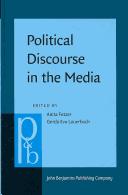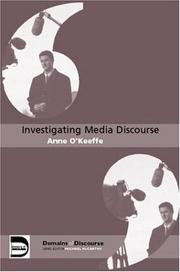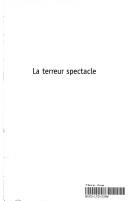| Listing 1 - 10 of 15 | << page >> |
Sort by
|
Book
ISBN: 9781350069145 1350069140 9781350069138 1350069132 Year: 2020 Publisher: London : Bloomsbury Academic,
Abstract | Keywords | Export | Availability | Bookmark
 Loading...
Loading...Choose an application
- Reference Manager
- EndNote
- RefWorks (Direct export to RefWorks)
Introduction to Multimodal Analysis is a unique and accessible textbook that critically explains this ground-breaking approach to visual analysis.Now thoroughly revised and updated, the second edition reflects the most recent developments in theory and shifts in communication, outlining the tools for analysis and providing a clear model that students can follow. Chapters on colour, typography, framing and composition contain fresh, contemporary examples, ranging from product packaging and website layouts to film adverts and public spaces, showing how design elements make up a visual language that is used to communicate with the viewer. The book also includes two new chapters on texture and diagrams, as well as a helpful image index so students can clearly understand how images and multimodal texts can be analysed from different perspectives.Featuring chapter summaries, student activities and a companion website hosting all images in full colour, this new edition remains an essential guide for students studying multimodality within visual communication in linguistics, media and cultural studies, critical discourse analysis or journalism studies.
Mass media and language. --- Modality (Linguistics). --- Visual communication. --- Modality (Linguistics) --- Communication visuelle --- Médias et langage --- Modalité (linguistique) --- Médias et langage --- Modalité (linguistique)

ISBN: 9027250995 1556197985 9786612163159 1282163159 9027298955 9789027298959 9781556197987 9781282163157 9789027250995 Year: 2000 Volume: 80 Publisher: Amsterdam Benjamins
Abstract | Keywords | Export | Availability | Bookmark
 Loading...
Loading...Choose an application
- Reference Manager
- EndNote
- RefWorks (Direct export to RefWorks)
This book is among the first to combine a historical view of media texts with a critical look at their textual diversity today. The thirteen chapters cover corpora of early news-papers and pamphlets, present-day news stories and commentaries, TV talk shows and commercials as well as internet presentations. The studies focus on the wide range of text types in 18th century newspapers and the interpersonal strategies of pamphlets; they pursue the development of the persuasive potential of headlines and advertisements right down to the sophisticated postmodernist and multilingual examples of today. Other topics are the definition and structure of news stories and commentaries, the interpersonal and multi-modal aspects of talkshows, and more radically, the questioning of the journalist's role in the age of the internet. Generally the stress is on the attention-getting side of media texts rather than on the manipulative qualities investigated by critical discourse analysis.
Pragmatics --- English language --- Mass communications --- Mass media and language. --- Discourse analysis. --- Médias et langage --- Analyse du discours --- Anglais (Langue) --- LANGUAGE ARTS & DISCIPLINES --- Linguistics / General --- Mass media and language --- Discourse analysis --- Communication & Mass Media --- Journalism & Communications --- Germanic languages --- Discourse grammar --- Text grammar --- Semantics --- Semiotics --- Language and mass media --- Language and languages

ISBN: 9789027254030 9027254036 9786612152924 1282152920 9027292272 9789027292278 9781282152922 6612152923 Year: 2007 Publisher: Amsterdam Benjamins
Abstract | Keywords | Export | Availability | Bookmark
 Loading...
Loading...Choose an application
- Reference Manager
- EndNote
- RefWorks (Direct export to RefWorks)
This book departs from the premise that political discourse is intrinsically connected with media discourse, as shaped by its cultural and transcultural characteristics. It presents a collection of papers which examine political discourse in the media from a cross-culturally comparative perspective in Arab, Dutch, British, Finnish, Flemish, French, German, Israeli, Swedish, US-American and international contexts. By using different theoretical frameworks, such as conversation analysis, discourse analysis, pragmatics and systemic functional linguistics, the papers reflect current moves in political discourse analysis to cross-disciplinary and methodological boundaries by integrating semiotics, particularly multimodality, cognition, context, genre and recipient design.
Politics --- Pragmatics --- Mass communications --- Mass media --- Mass media and language. --- Discourse analysis --- Political aspects. --- Discourse grammar --- Text grammar --- Semantics --- Semiotics --- Language and mass media --- Language and languages --- Communication in politics --- Mass media and language --- Communication & Mass Media --- Journalism & Communications --- Political aspects --- Mass media Political aspects --- Médias et langage --- Analyse du discours --- Médias et politique --- Aspect politique --- Médias et langage --- Médias et politique

ISBN: 0415364671 0415364663 9780415364676 9780415364669 9780203015704 9781134219025 9781134219063 9781134219070 Year: 2007 Publisher: London Routledge
Abstract | Keywords | Export | Availability | Bookmark
 Loading...
Loading...Choose an application
- Reference Manager
- EndNote
- RefWorks (Direct export to RefWorks)
Bringing together the methodologies of discourse analysis, conversation analysis and corpus linguistics, this book looks at the media extracts from a variety of perspectives in a practical way. The result is a wide range of sources, looked at using an eclectic range of methodologies and leading to numerous insights that any one of the methods could not have achieved alone.
Mass media and language --- Discourse analysis --- Research --- Methodology --- Discourse grammar --- Text grammar --- Semantics --- Semiotics --- Language and mass media --- Language and languages --- Methodology. --- Media discourse --- Taalgebruik in de media --- Media discourse. --- research. --- Médias et langage --- Research&delete& --- Pragmatics --- Mass communications --- Massamedia --- Methodologie. --- Taal --- Research. --- Discoursanalyse. --- Discourse analysis. --- Analyse du discours --- Recherche --- Méthodologie --- Mass media and language - Research - Methodology --- Discourse analysis - Research - Methodology

ISBN: 2804143287 9782804143282 Year: 2006 Volume: *15 Publisher: Bruxelles De Boeck
Abstract | Keywords | Export | Availability | Bookmark
 Loading...
Loading...Choose an application
- Reference Manager
- EndNote
- RefWorks (Direct export to RefWorks)
Où a vraiment lieu un événement terroriste ? Chacun sait que les victimes tuées ou mutilées sont situées quelque part... Mais l'adresse d'un événement terroriste est avant tout celle de la sphère publique où il réalisera sa vocation de message. Le terrorisme et les médias de l'image sont en effet les coproducteurs de l'un des grands genres discursifs contemporains, au même titre que les émissions de plateau ou la téléréalité. Avant de condamner le terrorisme, la télévision lui accorde une publicité sans laquelle il n'existerait pas. Ce partenariat forcé se traduit par l'émergence d'une nouvelle rhétorique. Il existe un lien direct entre la légèreté des vidéocaméras et la diffusion de ces innovations que sont les attentats-suicides et les décapitations ritualisées. Les performances de la télévision face aux versions contemporaines du terrorisme sont au coeur de ce livre, auquel ont contribué, dans une dizaine de pays, historiens, sociologues, anthropologues, sémioticiens, philosophes, psychanalystes, spécialistes des médias et des publics. Le terrorisme est ici un révélateur qui transforme notre compréhension du journalisme et de l'image.
Journalisme de télévision --- Media --- Médias --- Televisiejournalistiek --- Terrorisme --- Terrorism --- Television broadcasting of news --- Press coverage --- Television broadcasting of news. --- Press coverage. --- Terrorism and mass media --- Live television programs --- September 11 Terrorist Attacks, 2001, in mass media --- Mass media --- Mass media and language --- Terrorisme et médias --- Téléjournaux --- Emissions télévisées en direct --- Attentats du 11 septembre 2001, Etats-Unis dans les médias --- Médias --- Médias et langage --- Political aspects --- Aspect politique --- Télévision --- 11 septembre 2001, Attentats du (États-Unis) --- Médias et politique --- Émissions de nouvelles --- Émissions en direct --- À la télévision --- Terrorism in the press --- Television broadcasting --- Television coverage of news --- Television journalism --- Television news --- Broadcast journalism --- News --- Médias et politique --- 11 septembre 2001, Attentats du (États-Unis) --- Médias et politique. --- Médias et langage. --- À la télévision. --- Terrorism - Press coverage --- Médias et politique. --- Médias et langage.
Book

ISBN: 2753562954 2753549869 9782753549869 Year: 2018 Publisher: Rennes : Presses universitaires de Rennes,
Abstract | Keywords | Export | Availability | Bookmark
 Loading...
Loading...Choose an application
- Reference Manager
- EndNote
- RefWorks (Direct export to RefWorks)
Dans les espaces politiques civilisés de nos États parlementaires, les conflits politiques et les revendications ne prennent plus des formes violentes mais passent par l'usage de discours politiques contrôlés au sein d'un espace public institutionnalisé. Grève, mouvement social, opposition d'un groupe à une réforme du gouvernement, construction d'un problème public, demande d'une extension des prestations sociales : les occasions sont nombreuses au cours desquelles les différents protagonistes du jeu politique cherchent à convaincre les journalistes du bien-fondé de leur point de vue. Les interventions de groupes nouveaux – les représentants des « banlieues », ceux des victimes de l'explosion de AZF – s'entremêlent dans le récit journalistique de l'actualité avec les déclarations des porte-paroles d'organisations syndicales ou professionnelles plus institutionnalisés – CGT, MEDEF, Greenpeace, etc. – pour dessiner une arène publique dans laquelle l'action du gouvernement est discutée et réorientée continûment en fonction des rapports de force qui y sont construits. Aussi la tentation est forte pour les journalistes ou les analystes de considérer que la qualité des porte-paroles joue un rôle décisif dans le résultat final des interactions conflictuelles du jeu politique. Le talent d'Augustin Legrand ou celui d'Harlem Désir n'est-il pas à l'origine de la capacité des mouvements qu'ils représentaient d'obtenir la prise en compte des intérêts qu'ils défendent ? Au contraire, l'incapacité des pilotes d'Air France de défendre leurs intérêts lors de leur grève de 2014 n'a-t-elle pas pour cause les difficultés qu'ils ont eu d'avoir un porte-parole constant, disponible, ajusté aux contraintes des rédactions audiovisuelles et capable d'unifier aux yeux des journalistes les interventions des syndicats de pilote ? En ce sens, les rapports de force induits par les mouvements sociaux ne seraient plus véritablement matériels ou directs – le blocage des trains lors d'une grève…
Political Science --- porte-parole --- communication --- médias et politique --- Communication in politics --- Conflict management --- Crisis management --- Social conflict --- Crisis management in government --- Mediation --- Mass media and language --- Mass media --- France --- Collective bargaining --- Communication politique --- Gestion des conflits --- Gestion de crise --- Conflits sociaux --- Administration publique --- Médiation --- Médias et langage --- Médias --- Négociations collectives --- Political aspects --- Aspect politique --- Politics and government --- Politique et gouvernement --- Médias et politique. --- Mouvements sociaux --- Politique de la communication. --- Dans les médias.
Book
ISBN: 9789027258526 902725852X 1322205884 9027269424 9789027269423 Year: 2014 Volume: 112 Publisher: Amsterdam/Philadelphia John Benjamins Publishing Company
Abstract | Keywords | Export | Availability | Bookmark
 Loading...
Loading...Choose an application
- Reference Manager
- EndNote
- RefWorks (Direct export to RefWorks)
Audio description (AD) is a narrative technique which provides complementary information regarding the where, who, what and how of any audiovisual content. It translates the visuals into words. The principal function of this ad hoc narrative is to make audiovisual content available to all: be it a guided city tour of Barcelona, a 3D film, or a Picasso painting. Audio description is one of the younger siblings of Audiovisual Translation, and it is epigonic to the audiovisual translation modality chosen. This book is the first volume on the topic written in English and it brings together an inte
Mass communications --- Translation science --- #KVHA:Vertaalwetenschap --- #KVHA:Audiodescriptie --- Audio-visual materials --- Blind --- Mass media and language --- Translating --- Audio-visual aids --- Mass media and language. --- Audiodescriptie. --- Audiovisuele vertaling. --- Translating. --- Audio-visual aids. --- AVT (Audio-visual translation) --- Translating and interpreting --- Blind people --- Blind persons --- Blindness --- People with visual disabilities --- Deafblind people --- Language and mass media --- Language and languages --- Patients --- Audio-visual translation. --- Audiovisuel --- Aveugles --- Médias et langage --- Traduction --- Aides audiovisuelles --- Audio-visual materials - Translating --- Blind - Audio-visual aids
Book
ISBN: 9781905763917 1905763913 Year: 2012 Publisher: Manchester St. Jerome
Abstract | Keywords | Export | Availability | Bookmark
 Loading...
Loading...Choose an application
- Reference Manager
- EndNote
- RefWorks (Direct export to RefWorks)
Audiovisual Translation: Dubbing is an introductory textbook that provides a solid overview of the world of dubbing and is fundamentally interactive in approach. A companion to Audiovisual Translation: Subtitling, it follows a similar structure and is accompanied by a DVD. Based on first-hand experience in the field, the book combines translation practice with other related tasks - usually commissioned to dialogue writers and dubbing assistants - thus offering a complete introduction to the field of dubbing. It develops diversified skills, presents a broad picture of the industry, engages with the various controversies in the field, and challenges prevailing stereotypes. The individual chapters cover the map of dubbing in the world, the dubbing market and professional environment, text segmentation into takes or loops, lip-syncing, the challenge of emulating oral discourse, the semiotic nature of audiovisual texts, and specific audiovisual translation issues. The book further raises a number of research questions and looks at some of the unresolved challenges of this very specific form of translation. It includes graded exercises covering core skills that can be practised in class or at home, individually or collectively. The accompanying DVD contains sample film material in Dutch, English, French, Italian and Spanish, as well as a range of useful material related to professional practice.
ondertiteling --- audiovisuele communicatie --- Translation science --- Film --- Subtitling. Supertitling --- Dubbing of motion pictures --- Translating and interpreting --- Mass media and language --- Discourse analysis --- Littérature --- Médias et langage --- Films --- Analyse du discours --- Dubbing of motion pictures. --- Translating and interpreting. --- Mass media and language. --- Discourse analysis. --- Traduction --- Doublage --- Discourse grammar --- Text grammar --- Semantics --- Semiotics --- Language and mass media --- Language and languages --- Interpretation and translation --- Interpreting and translating --- Literature --- Translation and interpretation --- Translators --- Dubbing of moving-pictures --- Motion pictures --- Translating --- Dubbing --- Audiovisuele vertaling --- Massamedia --- vertalen --- taal --- Audiovisuele vertaling. --- Dubbing. --- vertalen. --- taal. --- Audio-visual translation --- Audiovisual translation --- Médias et langage. --- Analyse du discours. --- Traduction. --- Doublage. --- Littérature --- Médias et langage.
Book
ISBN: 9783110352573 9783110353242 3110352575 3110376830 3110353245 9783110376838 3110353253 9783110353259 Year: 2014 Publisher: Berlin De Gruyter
Abstract | Keywords | Export | Availability | Bookmark
 Loading...
Loading...Choose an application
- Reference Manager
- EndNote
- RefWorks (Direct export to RefWorks)
This collection of essays looks at two important manifestations of postclassical narratology, namely transmedial narratology on the one hand, and unnatural narratology on the other. The articles deal with films, graphic novels, computer games, web series, the performing arts, journalism, reality games, music, musicals, and the representation of impossibilities. The essays demonstrate how new media and genres as well as unnatural narratives challenge classical forms of narration in ways that call for the development of analytical tools and modelling systems that move beyond classical structuralist narratology. The articles thus contribute to the further development of both transmedial and unnatural narrative theory, two of the most important manifestations of postclassical narratology.
Fiction --- Literary rhetorics --- Mass communications --- Narration --- Analyse du discours narratif --- Médias et langage --- Médias --- Mass media. --- Narration (Rhetoric) --- Storytelling in mass media. --- Discourse analysis, Narrative. --- Mass media and language. --- 82-3 --- Proza. Fictie. Narratologie --- Erzähltheorie --- Intermedialität --- Narration. --- Médias et langage. --- Analyse du discours narratif. --- Médias. --- Narration (Rhetoric). --- 82-3 Proza. Fictie. Narratologie --- Erzähltheorie. --- Intermedialität. --- Language and mass media --- Language and languages --- Narrative discourse analysis --- Mass media --- Narrative (Rhetoric) --- Narrative writing --- Rhetoric --- Discourse analysis, Narrative --- Narratees (Rhetoric) --- Mass communication --- Media, Mass --- Media, The --- Communication --- 82-3 Fiction. Prose narrative --- Fiction. Prose narrative --- Narrative theory. --- film studies. --- literary studies. --- media studies. --- Médias et langage. --- Médias.
Book
ISBN: 1283942437 0739172611 9780739172612 0739172603 9780739172605 9781283942430 1498510973 9781498510974 Year: 2013 Publisher: Lanham, Maryland
Abstract | Keywords | Export | Availability | Bookmark
 Loading...
Loading...Choose an application
- Reference Manager
- EndNote
- RefWorks (Direct export to RefWorks)
The Normalization of War in Israeli Discourse, 1967-2008, by Dalia Gavriely-Nuri, provides intensive research on various manifestations of the Israeli "war-normalizing discourse," a set of linguistic, discursive and cultural devices aimed at blurring the anomalous character of war by transforming it into an event perceived as a ""normal"" part of life.
Mass media and war --- War in mass media --- Mass media and language --- War --- Israeli literature --- Discourse analysis --- Discourse grammar --- Text grammar --- Semantics --- Semiotics --- Hebrew literature, Modern --- Israeli literature (Hebrew) --- Armed conflict (War) --- Conflict, Armed (War) --- Fighting --- Hostilities --- Wars --- International relations --- Military art and science --- Peace --- Language and mass media --- Language and languages --- Mass media --- War and mass media --- Political aspects. --- Médias et guerre --- Guerre dans les médias --- Médias et langage --- Guerre --- Littérature israélienne --- Analyse du discours --- Terminology. --- Political aspects --- Terminologie --- Aspect politique
| Listing 1 - 10 of 15 | << page >> |
Sort by
|

 Search
Search Feedback
Feedback About UniCat
About UniCat  Help
Help News
News